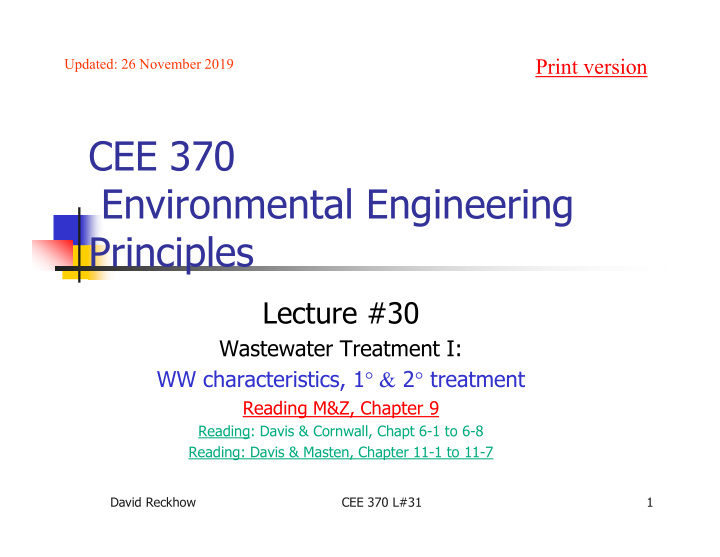



Print version Updated: 26 November 2019 CEE 370 Environmental Engineering Principles Lecture #30 Wastewater Treatment I: WW characteristics, 1 ° & 2 ° treatment Reading M&Z, Chapter 9 Reading: Davis & Cornwall, Chapt 6-1 to 6-8 Reading: Davis & Masten, Chapter 11-1 to 11-7 David Reckhow CEE 370 L#31 1
WW Parameters Conventional Toxics BOD Heavy metals TSS Chromium, etc. Pesticides Oil & grease Parathion, etc pH Industrial Nutrients Phenol, etc. Nitrogen PPCPs Ammonia Pharmaceuticals Nitrate Personal care products TKN Phosphorus Others TOC, etc. 2 CEE 370 L#31 David Reckhow
Wastewater Characteristics Municipal/Domestic WW 3 CEE 370 L#31 David Reckhow
Municipal WW Temporal Patterns in flow and quality Seasonal Weekly Daily 4 CEE 370 L#31 David Reckhow
On-site disposal Septic Systems Requires minor levels of maintenance 5 CEE 370 L#31 David Reckhow
Municipal WW Treatment Primary Solids removal Secondary Conventional Biological treatment BOD control Tertiary or Advanced Biological or chemical Nutrient control, etc Also must treat residuals (e.g., sludge) 6 CEE 370 L#31 David Reckhow
Conventional WW Treatment Primary Preliminary Biological Process Sedimentation Treatment Secondary Sludge Sedimentation Disinfection Sludge 7 CEE 370 L#31 David Reckhow
Saskatoon WWTP Activated Sludge 8 CEE 370 L#31 David Reckhow
Intro to WWT Incorporating 1 and 2 treatment May also need 3 treatment H&H, Fig 11-1, pp.360 9 CEE 370 L#31 David Reckhow
Small WWT Systems From a few hundred people to several thousand H&H, Fig 11-2, pp.361 10 CEE 370 L#31 David Reckhow
Design Loading & Parameters H&H, Table 1-1, pp.363 Peak hourly – often occurs during storm event 10 States Standards; 2004 Edition 11 CEE 370 L#31 David Reckhow
Preliminary Treatment Chemical addition H&H, Fig 11-4, pp.364 Not common Flow measurement Parshall flumes are most common Screening Pumping Grit Removal 12 CEE 370 L#31 David Reckhow
Screens Bar Screens openings from 0.5-2.25 in Cleaned by mechanical travelling rake Fabric Screens Finer (0.125-0.25 in), more common in Europe H&H, Fig 11-5, pp.365 13 CEE 370 L#31 David Reckhow
1 o Settling Rectangular or circular tanks Similar to drinking water treatment Flow enters behind an inlet baffle H&H, Fig 11-9, pp.368 Baffles placed in front of effluent weirs prevent loss of floating materials Removed by a mechanical skimmer (dual purpose) Primary Clarifier 14 CEE 370 L#31 David Reckhow
Biological Processes Secondary Treatment Activated Sludge Many variations Suspended growth Ponds & lagoons Many types Trickling Filters Attached Growth Rotating Biological Contactors Sludge Aerobic digestion Anaerobic digestion 15 CEE 370 L#31 David Reckhow
Microorganisms & treatment Stabilization of organic matter Mostly oxidation to CO 2 in aerobic processes Mostly to CH 4 & CO 2 in anaerobic processes Formation of cellular biomass Requires management of population Disposal of excess (biological sludge) May require intensive addition of electron acceptor O 2 added in some aerobic processes 16 CEE 370 L#31 David Reckhow
Activated Sludge Two components Aeration basin Clarifier & return sludge From University of Birmingham 17 CEE 370 L#31 David Reckhow
Activated Sludge Mixed liquor Return Activated sludge 1. Surface aerators 2. Bubble diffusers 18 CEE 370 L#31 David Reckhow
To next lecture 19 CEE 370 L#31 David Reckhow
Recommend
More recommend